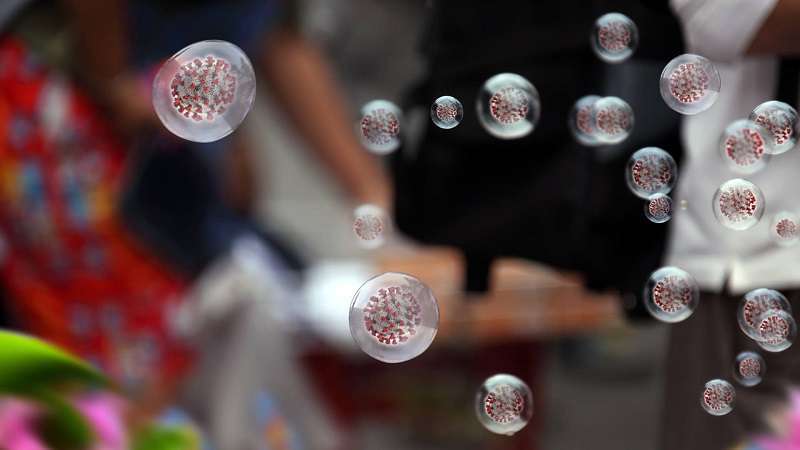Viruses such as SARS-CoV-2, influenza virus and others spread from person to person essentially by hitchhiking on aerosols — which are suspensions of fine solid particles or liquid droplets in air or other gasses.
In the case of virus infections the aerosols can contain liquid droplets that a virus infected person expels when coughing, sneezing, or simply exhaling, and this can be inhaled by someone else. This is a reason that healthcare providers often advise people to ventilate rooms effectively and filter indoor air, as the lowering of aerosol particle concentrations in homes, offices and public transport vehicles can reduce the risk of infection.
Although it is not clear how long viruses in aerosols remain infectious, some studies have suggested that the humidity and temperature of the air may play a role in virus persistence. Another factor that has been underestimated so far is the chemical composition of exhaled aerosols, in particular its acidity and its interactions with the indoor air. Until now, no research had yet been conducted on the effect the acidification of aerosols post exhalation has on the viral load they carry.
A team of researchers from ETH Zurich, EPFL and the University of Zurich in Switzerland have now investigated exactly that. In their study, the research team shows for the first time how the pH of aerosol particles changes in the seconds and hours after exhalation under different environmental conditions. Further, they show how this impacts the viruses contained in the particles.
According to the study, the exhaled aerosols acidify quickly, and the rapidity with which this acidification takes place depends on the concentration of acid molecules in the ambient air and the size of the aerosol particles. Using nasal mucus and lung fluid synthesized specifically for the study, the team examined the micro droplets. They found that in typical indoor air, it took these droplets only about 100 seconds to reach a pH of 4, which is roughly equivalent to the acidity of orange juice.
The pH value is a measure of acidity: a neutral solution has a pH of 7; the pH of acidic solutions is less than 7; that of basic solutions is greater than 7. Many viruses, such as influenza A virus, are acid-sensitive; exhaled aerosol particles can absorb volatile acids and other airborne substances, among them acetic acid, nitric acid or ammonia, from the indoor air, which in turn affects the acidity of the particles. The research team also found that the acidic environment can have a decisive impact on how quickly viruses trapped in exhaled mucus particles are inactivated.
The two kinds of virus were found to have different acid sensitivities: SARS-CoV-2 is so acid-resistant that at first the experts could not believe their measurements. It took a pH of below 2, i.e., very acidic conditions such as those in undiluted lemon juice, to inactivate the coronavirus. Such conditions cannot be reached in typical indoor air. Influenza A viruses, on the other hand, are inactivated after just one minute in acidic conditions of pH 4. Freshly exhaled mucus particles reach this level in less than two minutes in typical indoor environments.
Adding the time it takes to acidify the aerosol to the time it takes to inactivate the flu viruses at a pH 4 or lower, it quickly becomes clear that 99 percent of influenza A viruses will be inactivated in the aerosol after roughly three minutes. However, SARS-CoV-2 is a different story: since aerosol pH hardly ever falls below 3.5 in typical indoor spaces, it takes days for 99 percent of coronaviruses to be inactivated.
The study shows that in well-ventilated rooms, inactivation of influenza A viruses in aerosols works efficiently, and the threat of SARS-CoV-2 can also be reduced. In poorly ventilated rooms, however, the risk that aerosols contain active viruses is 100 times greater than in rooms with a strong supply of fresh air. The research suggests that indoor rooms should be ventilated frequently and well, so that the virus-laden indoor air and basic substances such as ammonia from emissions of people and indoor activities are carried outside, while acidic components of the outside air can enter the rooms in sufficient quantities.

